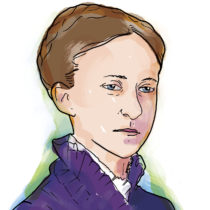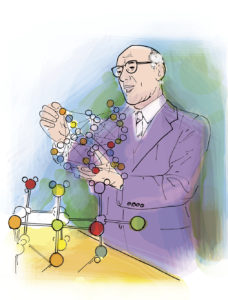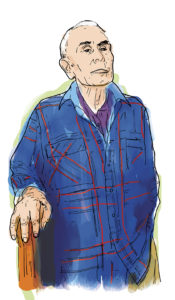Magazine

Five Moments that Shaped Michigan
By Robert Havey
Illustrations by Alvira/Hammond
A Complete Education
Judge Augustus Woodward arrived in Detroit on June 30, 1805, hoping to find an outpost of civilization in the pre-statehood Michigan wilderness. Woodward had left Virginian high society to become Michigan Territory’s first federal judge. He traveled for months through rough country in Ohio, stopping initially in the settlement of Monroe. Woodward was miserable there, finding no other men of learning in the glorified frontier town. Rumors of a large city on the lake drew him east, only to find that Detroit was destroyed a week before his arrival by a massive fire.
During the rebuilding of the city, Woodward met Father Gabriel Richard, a French Roman Catholic missionary who had been living in Detroit since 1798. The two quickly became friends, bonding over talks about history and Enlightenment philosophies.
Even in their humble environment far from civilization, Richard and Woodward believed deeply in classical education. Their conversations motivated Woodward to publish a book in 1816 titled A System of Universal Science, which detailed 13 “didaxim,” or subjects, that make up a complete education. The pair decided to bring these lofty ideas to life with a new type of school for a reborn Detroit. In a burst of classical-era zeal, he christened the new school “Catholepistemiad, or The University of Michigania.” Catholepistemiad, a word likely coined by Woodward, is mish-mash of Latin and Greek translates to roughly “School of Universal Knowledge.”
The cornerstone for the new school was laid down on September 24, 1817, in Detroit on the corner of Bates and Congress streets. Richard was to teach most of the “didaxim” and be vice president. Reverend John Montieth was appointed president.
The Catholepistemiad in Detroit never achieved the lofty goals set by its founders. After the University was established, most of the effort of the instructors was in making students worthy of admittance. Three primary schools and a “classical academy” were established to prepare Detroit’s youngest students for advanced studies.
The school fell into disuse by 1827. It was revived and moved to Ann Arbor in 1837 when Michigan achieved statehood.
Disturbing God’s Order
Alice Boise Wood (pictured above) studied Greek at the University of Michigan in 1866, four years before Madelon Stockwell became the first woman to officially enroll. Most universities forbade women from taking classes, and U-M was no exception. U-M’s first president, Henry Tappan, held the then popular view that women did not have the mental or physical fortitude for advanced studies. In a letter to a friend, Tappan said that to admit women would “disturb God’s order” and would “produce monstrosities.”
Wood’s father, James Robinson Boise, was a professor of Greek at the university and one of the few members of the faculty who supported coeducation. He insisted that his daughter be allowed to take his class after she graduated high school. President Haven relented, but Wood was not officially admitted, nor was her name ever on any student registry.
Wood had excellent preparation for her studies. She had loved language at an early age and was especially passionate about Greek. Her first test in the subject came early that semester, with a recitation in front of her classmates. She grew more and more nervous as she waited to be called on. Wood had heard horror stories about pioneering women at other institutions. She wondered: “Would they howl and hiss?” In this case, her peers choosing icy silence over jeering. “My lips did their work, even if my brain reeled; and the exact method did not fail me.”
Things wouldn’t always go this smoothly. One student, who had a “meek look, but had mischief in his eyes,” would scan Wood’s work closely, looking for a mistake. During one class he stood up and proclaimed that Wood had failed to include an iota subscript on a sentence she wrote on the blackboard. Wood was humiliated. She believed that this one mistake would doom not just her, but all women. “Dreadful Blunder! My heart was lacerated…I had Failed! Women would now never be admitted to the University!”
But many professors noticed the high quality of Wood’s work, and some even admitted her to attend their classes. In her one semester at U-M, she had earned high marks in Greek and Literature. Wood left Ann Arbor with her father in 1868 and became the first woman to graduate from the University of Chicago.
When new president James Angell and a new group of Regents took over in 1870, they quickly passed a resolution stating that the university was open to all who “possesses the requisite literary and moral qualifications.” This simple phrase has been cited many times over the years by those advocating for a more diverse University of Michigan.
Science and the Certainty of War
The early 1900s were an exciting time for science. Better modes of communication and travel allowed science to be a truly collaborative enterprise, with prominent professors going on worldwide tours. Physics Chair Harrison M. Randall made sure that the University of Michigan would be a part of this brave new world. Randall’s idea was to invite the biggest names in physics to lecture at U-M, allowing students and faculty to hear about the latest scientific discoveries from the people who made them. The Michigan Summer Symposium in Theoretical Physics was born.

The science of physics grew more and more international, but world politics intervened to tear it apart. The rise of the Third Reich had driven many Jewish scientists from top jobs in Germany and elsewhere. The certainty of war loomed over discovery and overshadowed every lecture tour.
A garden party was given in the Ann Arbor backyard of LSA Dean Edward Kraus in July, 1939. In attendance were two veterans of the U-M symposium, Nobel Laureate physicists Enrico Fermi and Werner Heisenberg. During the party, the two split off from the crowd and talked together about a subject neither cared for, but was pressing: politics. Fermi asked Heisenberg why he stayed in Germany, where many of his peers were either being driven out of the country or forced to work at the behest of the Nazi military. Heisenberg demurred, saying that “We have to decide for ourselves and cannot tell in advance whether we are doing right or wrong. Probably a bit of both.”
After they left the party in Ann Arbor, Fermi and Heisenberg found themselves on opposite sides of a world war. Fermi joined the Manhattan Project and Heisenberg worked on the German nuclear weapon project. After 1945, the field of nuclear physics became much more grim.
Physics at U-M benefited greatly from the reputation gained from the Summer Symposium. Randall was able to recruit faculty trained in European labs, like David M Dennison. Dean Kraus recruited Kasimir Fajans, a German-Jewish refugee and renowned physical chemist.
After the war, the Michigan Memorial Phoenix Project was established to find peaceful uses for nuclear energy.
Combating Discrimination
Representatives from a half dozen University of Michigan black student groups met in January 1970 to come up with a strategy for combating discrimination on campus. Despite efforts starting in the early 1960s by U-M to integrate black students and eliminate racial bias, many students believed the University was dragging its feet. The coalition soon took the name Back Action Movement, or BAM. After several unsatisfactory talks with University President Robben Fleming and the Regents, BAM decided to switch tactics.
The top priority for BAM was to increase black student enrollment at U-M to 10 percent of the total population by the 1973-74 academic year. BAM pointed out that the state of Michigan as a whole contained “a college-age population [that] is 18 percent black,” and to reach that level of representation at U-M at the current admission rate, it would take more than 120 years. Also discussed were changes to the Black Studies Program, the establishment of a Black Studies Center, and tuition waivers for financially disadvantaged students.
On February 5, President Fleming invited a number of BAM members to discuss the issues over dinner hosted at his home. The students did show up that evening, but not to be wined and dined. They handed Fleming a list of their demands and held a protest on the front lawn.
During a Board of Regents meeting on February 19, BAM members stormed out after the Regents refused to address their demands directly. A group of about 20 students went to the undergraduate library and took hundreds of books from shelves, closing the library for a day. This tactic was repeated the next day, after another refusal by the Regents to take immediate action. Fleming deployed Ann Arbor police officers at libraries on campus.
Fleming’s main dispute with BAM was that their demands were unreasonable given the budgetary restrictions the university faced. “[Members of the administration] simply do not wish to promise something [that] present information would indicate may not be possible.”
In the end, after months of demonstrations, walk outs, and press releases, Fleming and the Regents relented. A statement was released on March 19 addressing the BAM demands point by point, laying out a plan for the University to increase black enrollment and to fund programs directed at black students. While generally presumed to be a BAM victory, many administrators (including Fleming) saw the March 19th plan simply as a statement of what the University already had in the works.
Some things changed after BAM, but it wasn’t the end of the movement in Ann Arbor. After missing several goals laid out in the March 19 agreement, students once again organized in 1975 and again in 1987 to form BAM II and III.
In 1988, President James Duderstadt revealed the Michigan Mandate, a comprehensive program to increase minority representation among students, faculty, and staff.
The Fight for Gay Rights
When Jim Toy arrived at the University of Michigan in 1971 to start an Ann Arbor chapter of the Gay Liberation Front, he expected resistance. The Gay Rights movement was just starting to enter the public consciousness, and progress was slow. After a year of being largely ignored by University administration, Toy sent a request to university president Robben Fleming for space to hold a statewide gay rights conference. A letter came back denying the request, citing the need for a “police presence” on campus that the administration was unwilling to provide.

The HSO set up a 24-hour “gay hotline” for troubled students to call for emergency counseling. Years later, Toy pointed at his helping young people at the brink as his proudest accomplishment: “Hearing years later from people who were clients of mine that have said, ‘If it hadn’t been for you, I’d have killed myself.’ It’s not pride, but gratitude. I’m grateful I had the opportunity.”
In his long career, Toy has had to fight many battles on the shifting political landscape around gay rights. During the AIDS crisis in the 1980s and ’90s, he distributed crucial information about the disease to those most susceptible, while combatting radical plans proposed by anti-gay legislators (such as the internment of anyone HIV positive). Toy rallied supports after a 2004 amendment was passed by the state of Michigan to ban same sex marriage, redirecting outrage into fights for non-discrimination polices, health care for transgender youth, and adoption rights.
